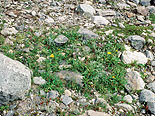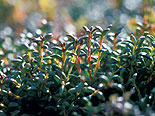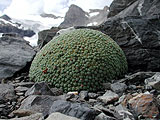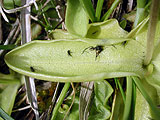 |
|
|
|
|
|
|
1 - Glacier forefield receiving additional nutrients |
An almost barren glacier forefield received slow release fertiliser. Look at the result! |
|
2, 3 - Glacier forefield community before and after fertiliser addition |
Nutrient addition causes species to become winners and losers. Slow growing cushion plants (Fig. 3) and small rosette species become overgrown by vigorously responding grasses and herbs (Fig. 4) when nutrients are added to a sparse glacier forefield community. |
|
4 - Loiseleuria procumbens |
Fertiliser addition causes massive growth stimulation. This Loiseleuria procumbens mat is twice as high (4 instead of 2 cm) as an unfertilised mat. |
|
5 - Androsace cushion |
On very nutrient (humus) poor substrates, plants are successful if they retain the nutrient capital they acquire year by year. The cushion form prevents the loss of dead biomass (leaf litter) through wind and water. A "private" compost heap creates a microcosm for a rich decomposer community in an otherwise barren environment. |
|
6 - The sticky Pinguicula leaves trap insects which are digested by enzymes excreted by leaf glands. |
On very poor soil, some species even trap insects and digest them to improve their diet. Insectivorous Pinguicula species are found both in the Alpine and the Arctic. |
29 August 2011 |
||
| |
||




